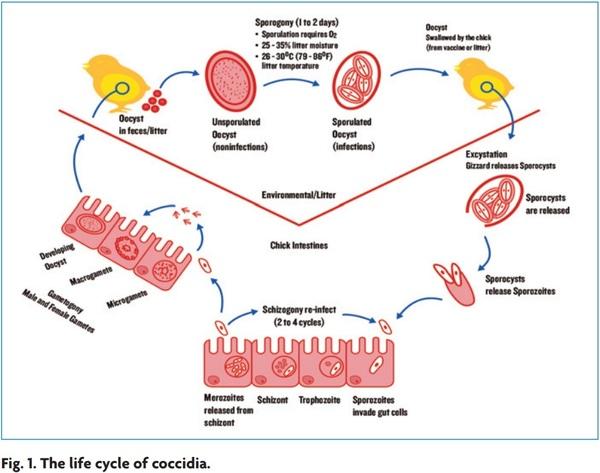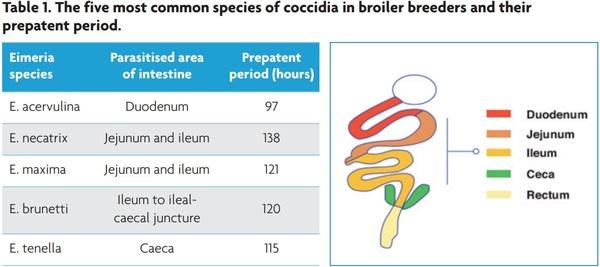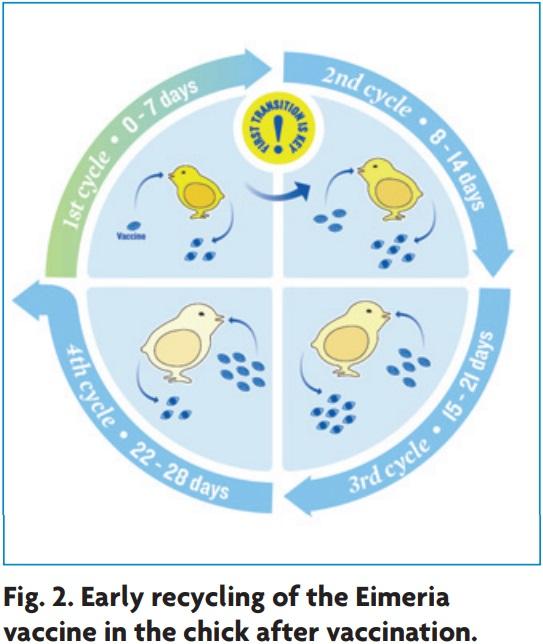Coccidiosis is a disease of the intestinal lining, produced by the invasion of the mucosal cells by a very prolific protozoan parasite of the genus Eimeria. This invasion results not only in the interruption of feeding and digestive processes involved in nutrient absorption but can also cause intestinal inflammation leading to dehydration, blood loss, loss of skin pigmentation, and increased susceptibility to secondary bacterial infections like necrotic enteritis and osteomyelitis.
Coccidia are prevalent in almost any poultry facility where chickens are raised. Although normally a disease of young chickens, any aged chicken without prior exposure and immunity is susceptible to coccidia.
In the past, clinical coccidiosis in broiler breeders was prevented by the use of anticoccidial medications (ionophores and non-ionophore anticoccidials [NIA]) in the feed. Then, after the worldwide introduction of commercial coccidiosis vaccines in the late ‘80s and early ‘90s, the strategy for coccidiosis control in long-lived birds was dramatically changed. Today, around 60-70% of breeder flocks are vaccinated at the hatchery, and the use of coccidiosis vaccines is commonplace whenever they are available. Vaccines are effective as long as they are managed and administered correctly and followed by adequate brooding practices to ensure the uniform cycling of coccidia within the flock. The objective when using a coccidiosis vaccine is for chicks to develop immunity early in their life with minimal intestinal damage.
Early immunity
When using a coccidiosis vaccine, achieving early immunity (within the first 3-4 weeks of a chick’s life) is essential for ensuring long-lasting protection throughout their life.
Vaccination at the hatchery is a controlled exposure method and the development of immunity to coccidia requires several consecutive cycles or passes through the bird in the field under particular management conditions.
The first exposure to the coccidia parasite takes place during vaccination. Regularly, this vaccination occurs at the hatchery, and the rest of the cycling process continues on the farm (following exposure and cycling).
Each cycle requires the ingestion of sporulated oocysts by the bird. The parasite invades and multiplies within the intestinal cells several times, and the cycle ends with the shedding of the unsporulated oocysts in the faeces. Then, under the right litter conditions (oxygen, temperature, and humidity), the oocysts sporulate in the litter, ready to repeat the cycle.
Biology and life cycle
The coccidia of chickens have a distinctive life cycle (Fig. 1). Previously unexposed chickens get infected by ingesting sporulated oocysts (infectious) to start the cycle, from either vaccination or the litter. The cycle is composed of two stages. The first stage occurs inside the chicken (schizogony and gametogony), lasting around 5-7 days; the second stage occurs in the environment/litter (sporogony) and lasts around 1-2 days, and this enables the oocyst to become infective.
A sporulated oocyst has four sporocysts, and each sporocyst contains two sporozoites. After ingestion, the oocysts’ walls are crushed by the physical activity in the gizzard, which releases the sporocysts (excystation process).
Pancreatic enzymes in the small intestine then release the sporozoites from the sporocysts enabling them to infect epithelial cells and begin the cycle in the intestine of the bird.
Immature oocysts shed by the bird remain dormant in the litter until specific litter conditions allow their sporulation. These conditions are:
• Oxygen.
• Litter moisture of 25-35%.
• Litter temperatures of 26-30˚C (79-86˚F).
It is essential to remember that for full immunity to develop, coccidia have to cycle in the bird 3-4 consecutive times. The length of the cycle and how many cycles are needed depends on the Eimeria species infecting the chicken. In general, the Eimeria species cycle between 5-7 days.
Diagnosis
Seven known Eimeria species infect chickens. These species are host-specific, meaning that they only infect chickens and do not infect other species of birds.
Diagnosis can be made by:
• Examining the location and the type of gross lesion found in the intestines. The parasite location and gross lesion in the intestines allow a presumptive rough diagnosis of the species of Eimeria involved, most of the time.
• Observing intestinal scrapings under a microscope to identify the species of Eimeria based on oocyst and schizont size and shape. The oocysts of E. maxima are remarkably large compared with other species.
• Collecting and fixing intestinal tissue samples in a container of buffered formalin solution for a histological diagnosis.
• Taking advantage of DNA technology, including PCR and sequencing, to identify every species affecting the birds.
Table 1 shows the most common Eimeria species found in broiler breeders and their prepatent period (time between exposure and shedding of the first oocyst)
Vaccine, administration and effect
There are different commercially available vaccines for use in broiler breeders. Most vaccines are based on suspensions of live (viable) sporulated oocyst.
They vary in the content of coccidia species, the number of oocysts, and strain pathogenicity. Also, coccidiosis vaccines can be originated from non-attenuated or selected precocious (attenuated) strains. Precocious strains cycle faster and are less pathogenic, but are also less prolific than the non-attenuated strains.
Most commercial vaccines available for broiler breeder pullets include E. acervulina, E. tenella, E. necatrix, E. maxima, E. mitis, and E. praecox, or a combination of selected species.
Different methods have been used to administer live coccidiosis vaccines to pullets and cockerels. The vaccine has been applied in the feed or the drinking water during the first week of life. At the hatchery, vaccines have been administered by coarse spray, solid gel pucks, or in ovo vaccination.
Today, most coccidiosis vaccines for broiler breeders are administered at the hatchery either via spray cabinet mist or gel droplets, and in some situations, chicks are revaccinated in the field.
If the chick’s intestine is healthy and the vaccine was adequately applied, live sporulated oocysts from the vaccine should replicate soon after their ingestion by the chick. The transition from the first to the second cycle is critical and must occur on the farm (Fig. 2).
The next generation of oocysts shed by the vaccinated chicks must sporulate before being ingested again by the birds and replicate into a second cycle (this sporulation is highly dependent on proper environmental conditions).
Then, following consecutive third and fourth cycles, robust immunity is achieved, and birds have protection against future coccidiosis challenges. Revaccination on the farm has been used in some operations to ensure adequate/uniform vaccine coverage and early oocyst cycling. Revaccination can be done using a coarse spray, in the water or feed, or oral gavage methods.
The development of immunity is dependent upon the early cycling of coccidia. In addition to an excellent initial vaccination, it is essential to provide the right conditions for the birds to experience the proper cycling starting at day one (optimal brooding conditions for optimal intestinal development).
Disruption in the process of going from the first cycle to the second will cause some birds to start building immunity, while others remain naive to coccidia. Poor uniformity of immunity increases the risk of coccidiosis outbreaks due to challenges with high numbers of oocysts infecting a naive population of chicks.
The consequences of these outbreaks are significant; treatment with anticoccidials may be required; bird welfare and performance will be adversely impacted, leading to financial losses.
Proper cycling ensures the development of immunity and results in:
• Better intestinal integrity.
• Uniform feeding and feed efficiency.
• Uniform bodyweight gain.
Improved bird health and flock livability factors affecting the vaccine response during grow-out
The factors highlighted below, either alone or in combination, impact the provision of an effective coccidiosis vaccination programme. The best place for coccidiosis vaccination is at the hatchery, where conditions are ideal for mass application and there is usually better control over the vaccination preparation and mixing process.
-Vaccine handling, storage, and administration
• Never freeze coccidiosis vaccine for it contains live oocysts.
• Follow manufacturer’s instructions for mixing the vaccine with diluent.
• Ensure a uniform distribution of the vaccine via spray cabinet mist or gel droplets. Administering vaccine in a way that ensures equal exposure of all chicks to live oocysts is of paramount importance (use a dye if necessary).
• Provide birds with enough time and light intensity after vaccination in the hatchery to allow preening.
• Keep chicks comfortable in terms of temperature and relative humidity after vaccination. Allow chicks to dry and avoid exposing them to high air speeds or draughts.
This article was originally published in International Hatchery Practice • Volume 35 Number 1.




















.jpg&w=3840&q=75)